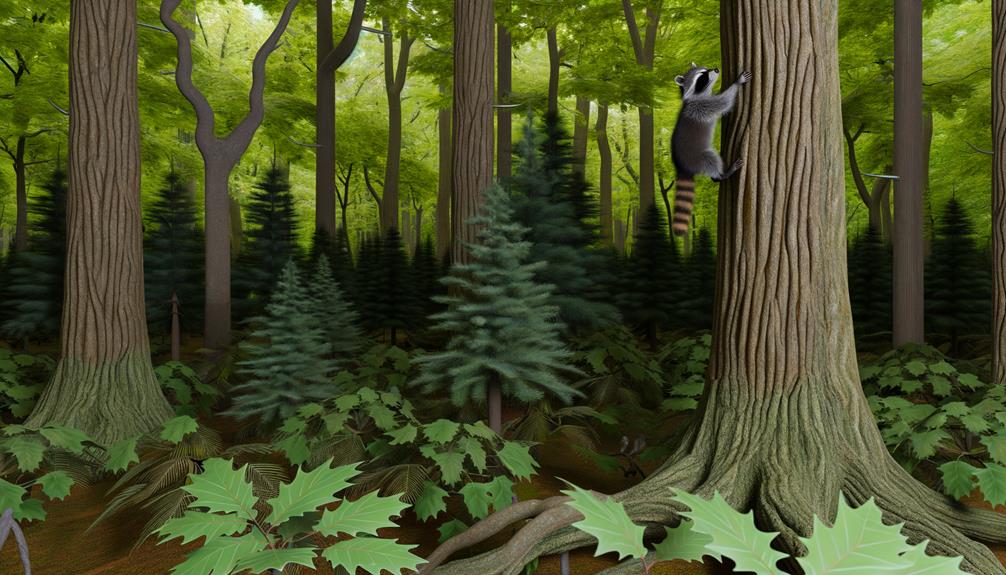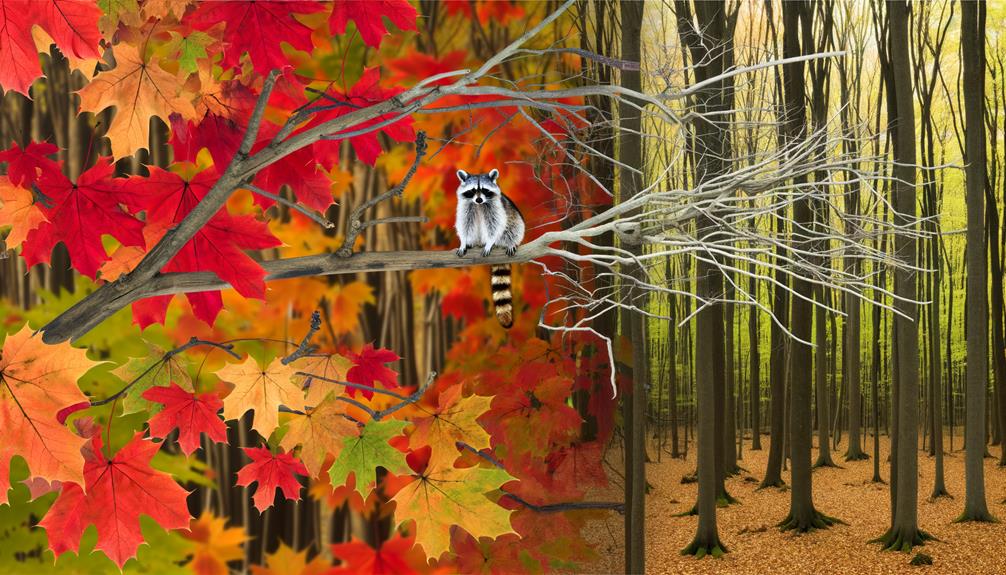Why Do Raccoons Live in Trees?
Raccoons can indeed live in trees, supported by their physical adaptations such as dexterous front paws, sharp claws, and rotating ankles that facilitate climbing and descending. They prefer mature hardwoods like oaks, maples, and pines due to their structural benefits and abundant food resources.
Tree cavities serve as shelters providing thermal insulation and predator avoidance. This arboreal lifestyle is complemented by their ability to adjust foraging strategies according to seasonal variations.
The robust adaptation to tree-dwelling highlights their evolutionary success in exploiting diverse ecological niches, offering further insights into their survival mechanisms and habitat preferences.

Key Takeaways
- Raccoons prefer nesting in tree cavities for shelter and protection.
- Dexterous paws and sharp claws enable raccoons to climb trees efficiently.
- Rotating ankles allow raccoons to descend trees headfirst.
- Raccoons favor mature hardwoods like oaks, maples, and pines for food and shelter.
- Seasonal behaviors include increased nocturnal foraging and winter torpor.
Raccoon Physical Adaptations

Raccoons possess a range of physical adaptations, such as dexterous front paws and sharp claws, that enable them to climb trees and navigate arboreal environments efficiently.
Their front paws, with five highly flexible digits, exhibit remarkable manipulative and tactile abilities, akin to human hands, facilitating the grasping of branches and small objects.
Observational data indicate that raccoons' claws provide a firm grip on various surfaces, enhancing their climbing proficiency.
Additionally, raccoons exhibit a robust skeletal structure and muscular limbs that support their weight and provide agility.
Studies have shown that these adaptations significantly contribute to their survival, allowing raccoons to exploit tree-based resources and evade predators.
Such physical characteristics underscore their evolutionary success in diverse habitats.
Tree-Climbing Abilities
Leveraging their physical adaptations, these nocturnal mammals exhibit remarkable tree-climbing abilities that enable them to access elevated food sources and nesting sites efficiently. Raccoons (Procyon lotor) possess several anatomical features that facilitate their arboreal prowess:
- Dexterous Forepaws: Equipped with five highly flexible digits, raccoons can grasp and manipulate tree branches with precision.
- Strong Hind Limbs: Their powerful hind legs, coupled with sharp, curved claws, provide exceptional traction and leverage for ascending vertical surfaces.
- Rotating Ankles: Unique among mammals, raccoons' hind feet can rotate 180 degrees, allowing them to descend trees headfirst—an essential adaptation for maneuvering arboreal environments.
These physiological traits collectively enhance raccoons' ability to exploit arboreal habitats, demonstrating their evolutionary adaptation to diverse ecological niches.
Types of Trees Preferred

A variety of tree species are preferred by raccoons for their arboreal activities. They show a particular inclination towards mature hardwoods such as oaks, maples, and pines due to their structural advantages and abundant food resources. These trees offer robust branches that support the raccoon's weight and provide easy access to higher elevations.
Data indicate that oaks are favored for their acorns, which constitute a significant dietary component for raccoons. Additionally, maples and pines are abundant in many raccoon habitats, offering shelter and safety from ground predators. Observational studies have shown that raccoons select trees with dense foliage, which helps in camouflage.
These preferences are driven by the need for safety, sustenance, and suitable resting locations.
Nesting and Shelter
In their arboreal habitats, raccoons show a preference for nesting in tree cavities. These cavities provide ideal shelter and protection from predators and environmental elements. They are often chosen based on their ability to offer:
- Thermal Insulation: Tree hollows can maintain more stable internal temperatures, essential for survival during extreme weather conditions.
- Predator Avoidance: Elevated nests reduce the likelihood of encounters with ground-based predators, improving the raccoons' survival rates.
- Proximity to Resources: Trees located near water sources and food supplies are favored, optimizing energy expenditure and foraging efficiency.
Studies indicate that raccoons' selection of nesting sites is influenced by these factors, highlighting their adaptability and strategic use of arboreal environments to ensure safety and access to resources.
Seasonal Behavior

Raccoons exhibit distinct seasonal behaviors, adjusting their activity patterns and foraging strategies in response to changing environmental conditions.
During warmer months, raccoons increase nocturnal foraging to exploit abundant food sources such as fruits, insects, and small vertebrates. Studies indicate a 30% rise in nocturnal activity during summer.
Conversely, in winter, raccoons reduce their activity, entering a state of torpor to conserve energy. Data from telemetry studies reveal that raccoons spend approximately 90% of their time in dens during cold periods, utilizing tree cavities for insulation.
Seasonal behavior also affects reproductive cycles, with breeding typically occurring between late winter and early spring. These adaptive behaviors underscore the raccoon's ability to thrive in diverse and fluctuating environments.
Predators and Threats
Raccoons, while arboreal, face significant threats that affect their survival rates. Predation by natural enemies such as owls and coyotes, combined with human-related dangers including vehicular collisions and habitat destruction, pose substantial risks.
Additionally, environmental hazards like severe weather events and disease outbreaks further threaten raccoon populations.
Natural Predators Impact
Although raccoons are adept climbers, their arboreal habitats do not completely safeguard them from natural predators such as owls, coyotes, and bobcats.
Observational data indicate that raccoons face significant predation risks even when residing in trees. Predation impacts can be categorized as follows:
- Owls: Nocturnal hunters, particularly the great horned owl, are known to prey on juvenile raccoons, exploiting their vulnerability during nighttime.
- Coyotes: These adaptable predators can climb or access lower tree branches, posing a threat to raccoons, especially when they descend to forage.
- Bobcats: Agile climbers themselves, bobcats can pursue raccoons into their arboreal refuges, leading to potential predation.
These natural predators underscore the complex dynamics raccoons face in maintaining their safety within tree habitats.
Human-Related Threats
In addition to natural predators, human-related threats heavily impact raccoon populations, often leading to habitat displacement and increased mortality rates. Urban expansion, deforestation, and road traffic are significant contributors.
Studies indicate that vehicle collisions account for a substantial proportion of raccoon fatalities, with mortality rates in urban areas exceeding those in rural environments. Additionally, the use of pesticides and rodenticides poses indirect threats by contaminating food sources.
Habitat fragmentation due to construction and land development further exacerbates the issue, isolating raccoon populations and reducing genetic diversity. Observational data reveal that raccoons increasingly seek refuge in urban settings, leading to heightened human-wildlife conflict and subsequent control measures, including trapping and relocation, which further stress raccoon populations.
Environmental Hazards Factors
Within their natural habitats, raccoons face numerous environmental risks, including predation by larger mammals and birds of prey. These risks greatly influence their behavior and habitat choices. Observational data suggest that raccoons employ various adaptive strategies to reduce these dangers.
Key environmental risks include:
- Predation by Larger Mammals: Coyotes and bobcats are known to prey on raccoons, especially in less urbanized areas.
- Birds of Prey: Eagles and owls pose significant aerial threats, especially to juvenile raccoons.
- Disease Transmission: Raccoon populations are vulnerable to rabies and canine distemper virus, which can devastate local populations.
Understanding these threats is essential for wildlife management and conservation efforts to ensure raccoon populations remain stable and healthy within their ecosystems.
Conclusion
Raccoons exhibit remarkable physical adaptations that enable tree-dwelling behavior, including dexterous limbs and sharp claws for climbing. They demonstrate a preference for tree species that offer abundant shelter and food resources.
Seasonal behaviors indicate varying nesting patterns, often influenced by environmental conditions. Predation risks and threats further shape their arboreal habits.
Like sentinels in the canopy, raccoons navigate the vertical landscape, utilizing trees for both refuge and sustenance, underscoring the intricate balance within their ecosystem.






